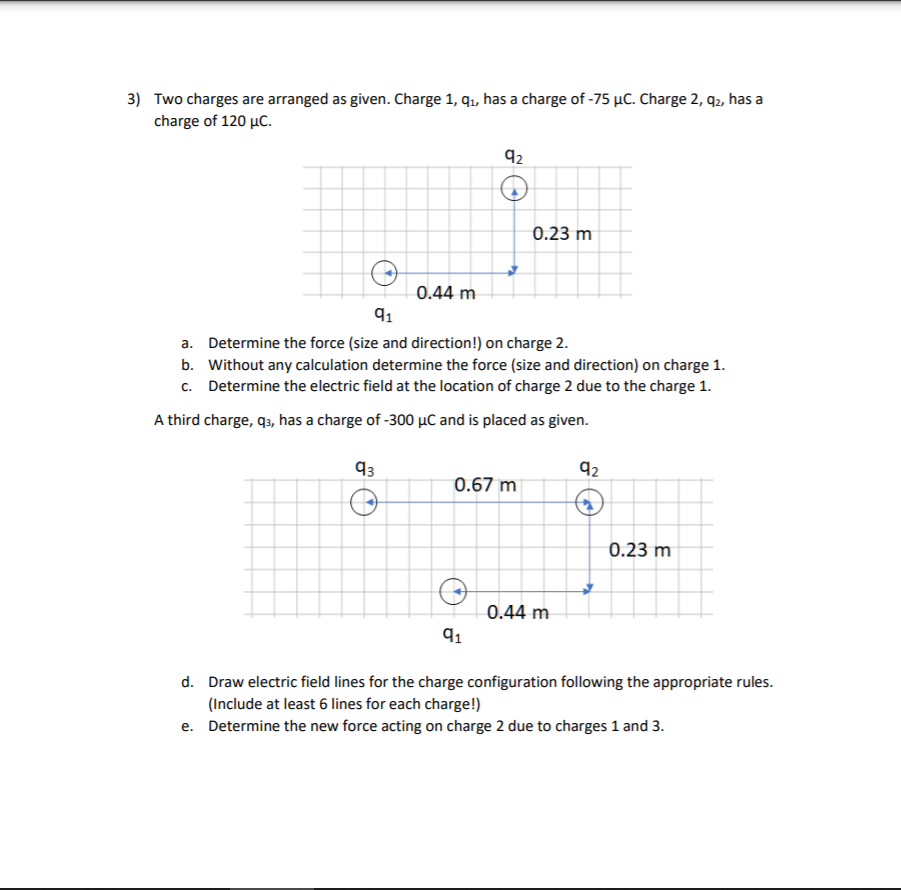3) Two charges are arranged as given. Charge 1, qı, has a charge of -75 µC. Charge 2, q2, has a charge of 120 µC. 92 0.23 m 0.44 m 91 a. Determine the force (size and direction!) on charge 2. b. Without any calculation determine the force (size and direction) on charge 1. c. Determine the electric field at the location of charge 2 due to the charge 1.
3) Two charges are arranged as given. Charge 1, qı, has a charge of -75 µC. Charge 2, q2, has a charge of 120 µC. 92 0.23 m 0.44 m 91 a. Determine the force (size and direction!) on charge 2. b. Without any calculation determine the force (size and direction) on charge 1. c. Determine the electric field at the location of charge 2 due to the charge 1.
Physics for Scientists and Engineers, Technology Update (No access codes included)
9th Edition
ISBN:9781305116399
Author:Raymond A. Serway, John W. Jewett
Publisher:Raymond A. Serway, John W. Jewett
Chapter23: Electric Fields
Section: Chapter Questions
Problem 23.30P: Three charged particles are at the corners of an equilateral triangle as shown in Figure P23.15. (a)...
Related questions
Concept explainers
Topic Video
Question
solve question 3 A-E please

Transcribed Image Text:3) Two charges are arranged as given. Charge 1, q1, has a charge of -75 µC. Charge 2, q2, has a
charge of 120 µC.
92
0.23 m
0.44 m
91
a. Determine the force (size and direction!) on charge 2.
b. Without any calculation determine the force (size and direction) on charge 1.
c. Determine the electric field at the location of charge 2 due to the charge 1.
A third charge, q3, has a charge of -300 µC and is placed as given.
93
92
0.67 m
0.23 m
0.44 m
91
d. Draw electric field lines for the charge configuration following the appropriate rules.
(Include at least 6 lines for each charge!)
e. Determine the new force acting on charge 2 due to charges 1 and 3.
Expert Solution
This question has been solved!
Explore an expertly crafted, step-by-step solution for a thorough understanding of key concepts.
This is a popular solution!
Trending now
This is a popular solution!
Step by step
Solved in 4 steps with 1 images

Knowledge Booster
Learn more about
Need a deep-dive on the concept behind this application? Look no further. Learn more about this topic, physics and related others by exploring similar questions and additional content below.Recommended textbooks for you

Physics for Scientists and Engineers, Technology …
Physics
ISBN:
9781305116399
Author:
Raymond A. Serway, John W. Jewett
Publisher:
Cengage Learning

College Physics
Physics
ISBN:
9781305952300
Author:
Raymond A. Serway, Chris Vuille
Publisher:
Cengage Learning

College Physics
Physics
ISBN:
9781285737027
Author:
Raymond A. Serway, Chris Vuille
Publisher:
Cengage Learning

Physics for Scientists and Engineers, Technology …
Physics
ISBN:
9781305116399
Author:
Raymond A. Serway, John W. Jewett
Publisher:
Cengage Learning

College Physics
Physics
ISBN:
9781305952300
Author:
Raymond A. Serway, Chris Vuille
Publisher:
Cengage Learning

College Physics
Physics
ISBN:
9781285737027
Author:
Raymond A. Serway, Chris Vuille
Publisher:
Cengage Learning

College Physics
Physics
ISBN:
9781938168000
Author:
Paul Peter Urone, Roger Hinrichs
Publisher:
OpenStax College


Physics for Scientists and Engineers with Modern …
Physics
ISBN:
9781337553292
Author:
Raymond A. Serway, John W. Jewett
Publisher:
Cengage Learning